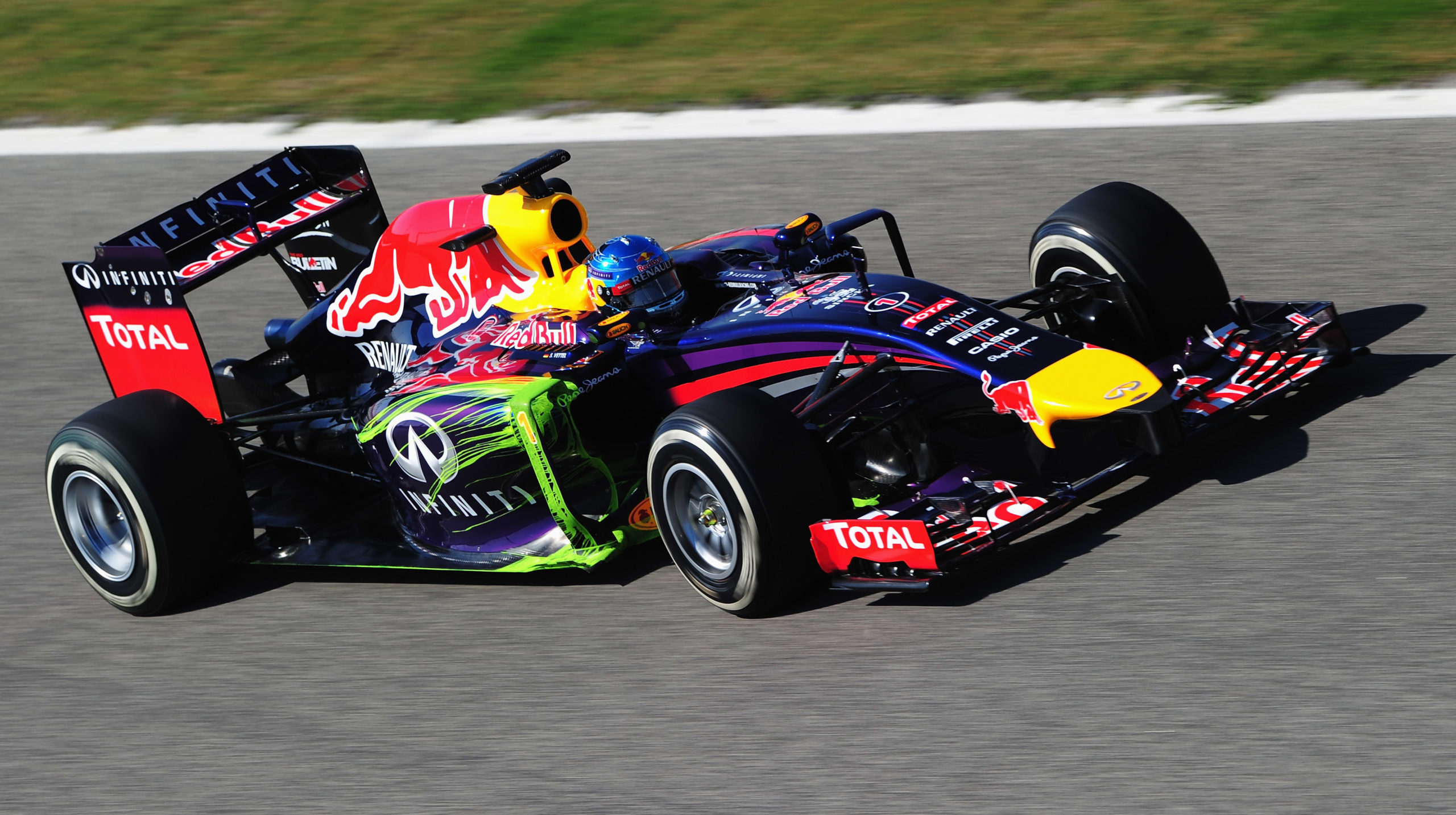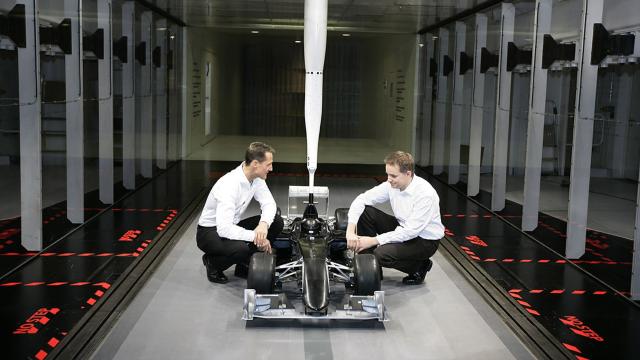In its push to drastically reduce costs and be a lot more ecofriendly, Formula One has been tossing around the idea of banning — or at least seriously restricting — the use of wind tunnels in car development. But to really understand the ramifications of that decision, you have to really delve into the wind tunnel: its importance, its history, its use — all of that good stuff. So buckle in, because we’re guiding you through.
The History
There used to be a time in racing when no one knew what the hell aerodynamics were and instead just relied on building the most lightweight chassis that could hold the most powerful engine possible. Then Colin Chapman slapped a wing on the back of his Lotus, pissed off his drivers, and realised that you can make cars stick to the ground via air flow if you basically do the opposite thing that an aeroplane wing does.
Now, I’m not going to get into the ins and outs of race car aerodynamics (that’s a blog for a different time). But as technology continued to advance throughout the 1970s and 80s, it became obvious that a more regulated form of research was crucial to determining the effect of the aero changes. That’s where the wind tunnel comes in.
The first team to use a wind tunnel in F1 was Brabham back in 1963, but that was more an effort to get ahead of the game than it was anything else. Using wind tunnels didn’t become standard until the 1980s.
Mainly, the whole goal is to make sure that every single stream of air that touches a car is optimised and used for a specific, performance-enhancing purpose.
How The Tunnel Works
A wind tunnel is, essentially, a tubular chamber with a very large fan that sends high-powered air streams over the body of a car to analyse air flow patterns.
There are two different kinds of wind tunnels. The first is an open circuit tunnel, which has an air entry open to the outside atmosphere. The second is a closed circuit tunnel, which prevents that outside influence — and, as such, provides a more uniform flow of air. If you haven’t already guessed, F1 teams use the closed circuit tunnel.
To study an F1 car, a team of highly-skilled engineers craft a scale model of the actual F1 car in question to use in the tunnel. These models are usually about 50-60 per cent of the size of the actual car. That model is placed in a specific place in the tunnel, which is shaped a little like a loop. Air flow is channeled via a large turbine (or, if you’re not a money-laden team like Mercedes, via several different fans). Air washes over the car, then is sucked back into the fan and blasted over the car again.
You really want that big fan. It creates less turbulence and is far more efficient than trying to make five little fans work the same way. The airflow needs to be predictable if you want to learn anything. At this point, it’s less about real-world conditions and more about making sure the car isn’t going to lift off the ground.
The walls of the tunnel are designed to be as smooth as possible to prevent any unnecessary disturbance in air flow. Air is directed through the loop via turning vanes at each corner, which are, again, designed to disturb the airflow as little as possible and instead just move it where it needs to go.
There are also a few different places of note in the tunnel itself:
- The testing area, where the car is secured to a stand that measures the downforce or lift generated by the wind. This is the narrowest point of the tunnel, forcing the air flow to gain power and momentum just before washing over the car
- The drive area, or the place where the wind is pushed through the fan
- The diffuser, which is a gradually widening section of the tunnel that helps to slow the air and make it easier to direct
- The settling area, a bulbous portion of the tunnel just before the testing area, where air is forced through a honeycombed mesh that redirects the flow into a straight, predictable path
- The breather and/or chiller unit are located somewhere within the loop to prevent air pressure from skyrocketing as moving air heats up
The testing area itself is also composed of several different parts:
- One or two long arms that hold the car in place
- A rolling road underneath the car that matches the wind speed and prevents the air from sticking to the road and presenting inaccurate data
- The car itself, which is only allowed to be, at maximum, 60 per cent of the size of a regular F1 car
If you’re much better understanding visuals, then you’re in luck. Chain Bear has a great video on YouTube that easily explains what you’re looking for with a wind tunnel:
How To Gather Data
A race car is designed for a very specific purpose: to cut through the air in the most efficient way possible in order to go fast. It’s impossible to design a car that does only that, so certain components are designed to whisk the air away with as little disturbance, and other components — like the front wing — are designed to direct the airflow somewhere else in order to increase downforce or speed. But how do you do that?
There are a few easy ways, but all of them basically rely on creating a concrete visualisation of air flow paths. If you’ve ever seen an F1 car at a test session covered in streaks of neon paint, that’s air flow visualisation in practice.

That neon paint is called flo-vis, and it shows how air is moving across the surface of the car. Other forms of visualisation include:
- Wool string or tufts, which align themselves with the wind direction of the car. A great visualisation of that came in the recent Ford vs. Ferrari film, when pieces of string were attached all over the body of the GT40.
- Pitot tubes, which measures the difference between stagnant air and flowing air. These are those cage-like objects attached to F1 cars during testing sessions — when they’re that complex, they’re called aero rakes. The larger surface allows for a better representation of air flow across a wide swath of space.
- Smoke visualisation, which does exactly as it sounds. Throw a light smoke into the tunnel, and you could watch the way it streamed over the car. It’s just hard to introduce that without messing up the smooth air flow you’ve worked so hard to develop.
- Particle Image Velocimetry, which is a more advanced form of smoke visualisation. In this case, the smoke is the same density as the air around it, and you run the turbine until the entire tunnel is saturated with this smoke, effectively becoming the airflow and preventing disturbance. Taking photos with a strobe light and feeding them to the computer creates a way to analyse particles as they pass over the car. You compare two or more images, and you can see the differences or similarities, which helps predict how that air will flow in a race setting.
- Laser Doppler Anemometry, which splits a laser over different points in the air flow of the tunnel and, through some complex science, creates a doppler effect that’s proportional to the air flow in the tunnel. It’s a way to discover flow velocity, and I’ll let someone more qualified run you through the details.
- Surface pressure taps, which involves poking tons of tiny holes over the surface of the car that feature diaphragms that react to changes in air pressure and allow you to gauge the pressure acting on the entire car.
- Sensors, which detect forces that act in certain directions.
In addition to straight-on air flow testing, F1 teams are able to recreate track conditions in order to see how their car will perform at, say, Brazil when compared to France. The whole goal is to have a constantly rotating selection of parts to fit to the car, test, and analyse in order to decide which is going to be the best option for the upcoming season.
Once you’ve run your car through a wind tunnel for a while and gathered a nice, tidy set of data, it’s time to make sense of it — which is, of course, a conversation for another time.
The Controversy
Right now, there’s a fair share of controversy over wind tunnels. They cost tens of millions of dollars to build and additional millions to run. Some teams can’t afford their own tunnel and have to use that of a different team, and some other teams have been able to afford two or more tunnels. It costs a hell of a lot of money to run a car through the tunnel on a regular basis, and it’s a drain on energy resources as well. Before restrictions started being placed in 2009, F1 teams would run their tunnel every single day, all day long.
It is possible to reduce wind tunnel time with a more effective use of computational fluid dynamics, or CFD, a form of computer analysis that enables you to input all the dimensions of your car and let a program tell you how the car is expected to perform. The software is always growing, and it requires a lot less work, money, and physical space than running physical tests in a wind tunnel.
Reducing wind tunnel time is going to play a big role in the next few years, which you can read more about here. But right now, it seems like we’re going to be moving away from wind tunnels and toward something more fully computerised.
